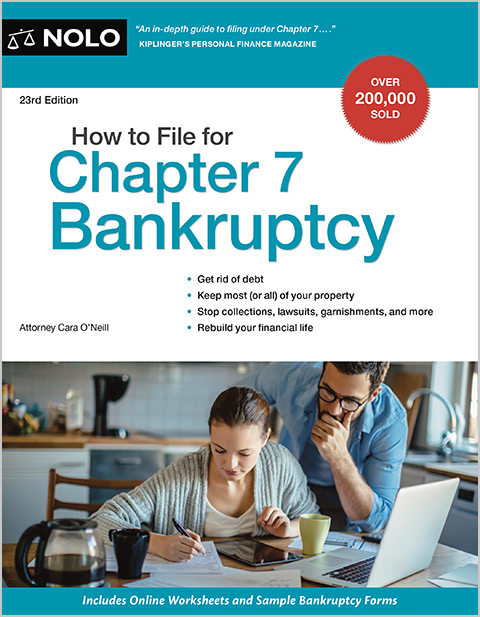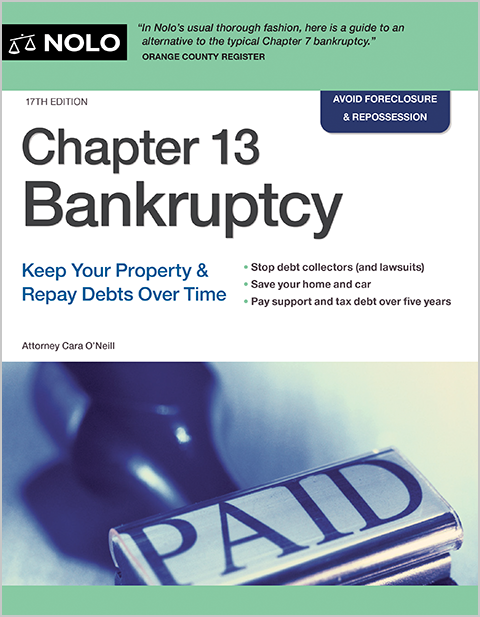If you have a car loan, you might be able to keep your car in Chapter 7 bankruptcy by reaffirming the loan.
When you file for Chapter 7 bankruptcy and have a car loan, you must indicate whether you intend to keep the car or return it in your bankruptcy paperwork. If you want to keep it, you'll have to do several things, such as protect the vehicle equity from the Chapter 7 trustee and pay the balance owed on the car. If you want to ensure the lender can't take the car from you after Chapter 7, you'll enter into a new contract by "reaffirming the car loan."
- What Is a Reaffirmation Agreement?
- Can I Keep the Car If I Make Loan Payments After Chapter 7?
- What Happens If I Don't Reaffirm My Car Loan?
- How Do I Reaffirm a Car Loan in Chapter 7 Bankruptcy?
- Steps for Reaffirming a Car Loan in Chapter 7 Bankruptcy
- Pros and Cons of Reaffirmation Agreements: Reaffirm or Pay Without a Contract?
- Will the Bankruptcy Court Approve Your Reaffirmation Agreement?
- Need More Bankruptcy Help?
What Is a Reaffirmation Agreement?
Most people need a car to travel to work, school, and medical appointments. If they lost their vehicle, many wouldn't have a way to buy another.
A reaffirmation agreement can help you maintain transportation after Chapter 7 bankruptcy. It stops a lender from taking the vehicle if you're paying as agreed.
Can I Keep the Car If I Make Loan Payments After Chapter 7?
It depends. Some lenders will allow you to continue paying the loan without entering into a reaffirmation agreement. The benefit? Without a contract, you wouldn't be responsible for paying anything if you couldn't continue making payments.
Here's what that would look like: You'd stop making payments, the lender would collect the car in whatever condition it might be in, and you'd walk away with no further liability.
What Happens If I Don't Reaffirm My Car Loan?
Without a payment contract, the lender could repossess the car at any time, even if you continued making monthly amounts and remained current. Also, you wouldn't benefit from timely payments because the lender wouldn't report payments to credit bureaus.
How Do I Reaffirm a Car Loan in Chapter 7 Bankruptcy?
You'll sign a new contract with the lender on the same terms as before. The new contract is known as a "reaffirmation agreement" because in the new contract, you "reaffirm" or agree to continue paying for the car as if you hadn't filed for bankruptcy.
Although most reaffirmation agreements' principal and interest payments remain unchanged, you could negotiate better terms or even roll late payments into the amount owed. However, the lender isn't obligated to work with you.
Steps for Reaffirming a Car Loan in Chapter 7 Bankruptcy
Not everyone qualifies for a reaffirmation agreement. You'll want to do these things to check whether you can make it work.
- Can you protect your vehicle equity?
- Is your car loan current?
- Can you afford your car payment after Chapter 7?
- Do you need a reaffirmation agreement?
- Will the court approve your reaffirmation agreement?
If you can't satisfy a step, consider learning about other Chapter 7 bankruptcy car options.
Can You Protect Your Car Equity From the Chapter 7 Bankruptcy Trustee?
If you can't protect all of your vehicle equity with a bankruptcy exemption, you'll end up with a small amount of cash instead of your car at the end of the case. Why? Because when you file for Chapter 7 bankruptcy, you're allowed to keep or "exempt" only the things your state believes you'll need to work and live. The trustee assigned to your case sells any "nonexempt" property for the benefit of your creditors.
You can use exemptions to protect vehicle equity. However, bankruptcy exemptions aren't always sufficient to fully cover a car's equity. In that case, the Chapter 7 bankruptcy trustee might let you pay the nonexempt portion and keep the car. If not, the trustee will sell the car, give you the exemption amount, and pay creditors what remains after deducting sales costs and the trustee's fee.
When reviewing your state exemptions, you'll want to determine how much equity the "motor vehicle" exemption will let you keep. Check for a "wildcard" exemption if it isn't enough. Also, some states allow filers to use the federal bankruptcy exemptions if they're more advantageous. Whichever set you choose, you must use it exclusively.
If you can't protect your equity and would lose the car to the trustee, there's no reason to continue the analysis. If you can overcome this hurdle and are making car payments, there's more to do.
Learn whether you can keep two cars in Chapter 7.
Can You Prevent the Lender From Taking Your Car During Chapter 7?
When you file for Chapter 7 while behind on your car loan, your bankruptcy lawyer can't guarantee you'll be able to keep the vehicle. So if you're hoping to avoid losing the car by asking the lender to restructure your loan in a reaffirmation agreement, you should understand the lender isn't obligated to and could decide to repossess your car instead.
The lender's options include asking the judge to "lift the automatic stay" to allow the lender to pursue repossession or waiting to repossess the car after the case ends. By contrast, if your payment is current, the bankruptcy judge won't lift the stay unless you're breaking some other loan term.
Find out why Chapter 7 won't help with late car payments.
Will You Be Able to Afford Your Car Payment After Chapter 7 Bankruptcy?
You also must keep your car payment current after filing for bankruptcy to avoid repossession because even though Chapter 7 erases the lender's right to the car payment, Chapter 7 doesn't erase the lender's lien against your car.
A lien gives the lender the right to recover the vehicle if you fall behind on your payments—even if you file for bankruptcy. If you decide not to pay, the lender will use the lien rights to pick up the car.
You can streamline the process by voluntarily giving the lender the car and walking away with no debt. But if you want to keep it, you must agree to continue paying for it even though Chapter 7 will erase the car loan.
Learn more about keeping your car in Chapter 7 and debts you can discharge in bankruptcy.
Pros and Cons of Reaffirmation Agreements: Reaffirm or Pay Without a Contract?
Here's where it gets interesting. Most lenders want your money, not the car, and will let you keep the car after Chapter 7 if you keep paying and stay current. What you do will depend on your credit score needs and risk tolerance.
Pros and Cons of Paying Without a Contract
The benefit of paying without a contract is if the vehicle is damaged, breaks down, or you don't want it anymore, you can give it back and walk away. However, the lender can take back the vehicle at any time. Also, the lender won't report timely payments to credit bureaus.
Pros and Cons of Signing a Reaffirmation Agreement
The primary problem with signing a reaffirmation agreement is you'll still have a car loan after bankruptcy. You'll lose the Chapter 7 benefit of eliminating your car loan by signing the reaffirmation agreement. If you miss payments and the lender repossesses the car, you'll be liable for any deficiency balance remaining after the lender sells it at auction.
Some of the benefits of a reaffirmation agreement include the following:
- You secure your interest rate and payment. After a Chapter 7 bankruptcy, obtaining a car loan isn't impossible. Still, your interest rates will be high, and you will likely only be able to obtain financing through a subprime lender. If you turn in your current car and need to finance a new one, you probably won't get terms as favorable as your old loan.
- You don't have to start over again with a new loan term. If you surrender your car in bankruptcy, you might have to buy another car on credit, which would mean more years of payments.
- You know what to expect. Reaffirming an existing loan means maintaining a relationship with the same lender and keeping the same loan terms. Also, the payments will help you rebuild your credit after bankruptcy.
Example. Chloe reaffirmed the loan on her car in Chapter 7. Six months after her Chapter 7 discharge, Chloe defaulted on her payments. When the lender repossessed the car, Chloe owed $10,000. The lender sold the car at auction for $6,000 and incurred $300 in auction fees. Chloe is responsible for the $4,000 deficiency balance plus the auction fees.
Will the Bankruptcy Court Approve Your Reaffirmation Agreement?
To reaffirm a car loan, you must be able to show the court that the vehicle is necessary and that the payment is reasonable. You must also demonstrate that the car payment isn't an undue hardship on your household and that you'd be able to afford the necessities of life.
Need More Bankruptcy Help?
Did you know Nolo has made the law accessible for over fifty years? It's true—and we wholeheartedly encourage research and learning. You'll find many more helpful bankruptcy articles on Nolo's bankruptcy homepage, and information needed to complete the official downloadable bankruptcy forms is located on the Department of Justice U.S. Trustee Program.
However, online articles and resources can't address all bankruptcy issues and aren't written with the facts of your particular case in mind. The best way to protect your assets in bankruptcy is by hiring a local bankruptcy lawyer.
|
|
- What Is a Reaffirmation Agreement?
- Can I Keep the Car If I Make Loan Payments After Chapter 7?
- What Happens If I Don’t Reaffirm My Car Loan?
- How Do I Reaffirm a Car Loan in Chapter 7 Bankruptcy?
- Steps for Reaffirming a Car Loan in Chapter 7 Bankruptcy
- Pros and Cons of Reaffirmation Agreements: Reaffirm or Pay Without a Contract?
- Will the Bankruptcy Court Approve Your Reaffirmation Agreement?
- Need More Bankruptcy Help?

